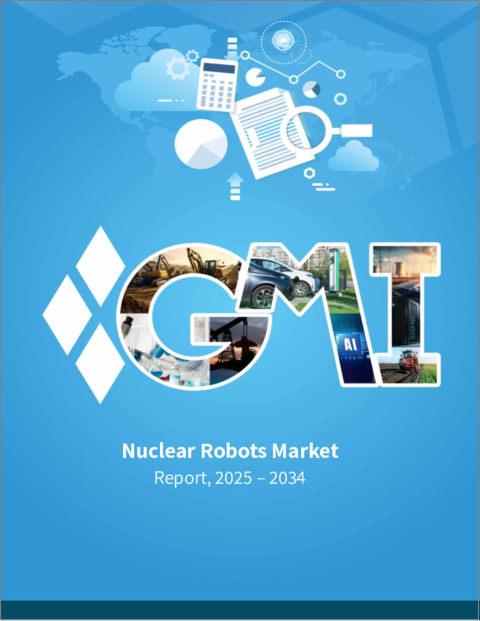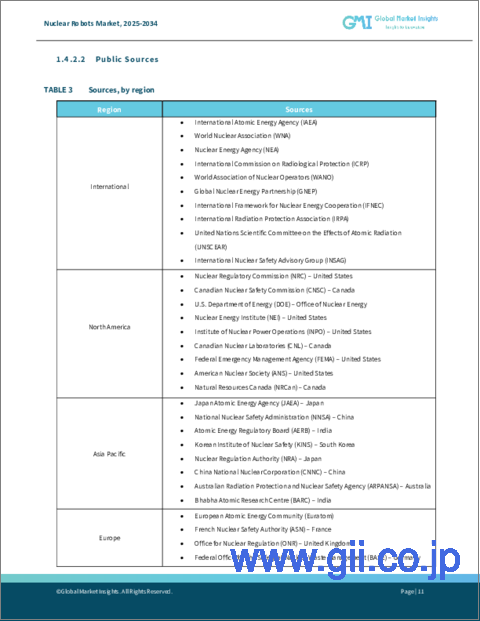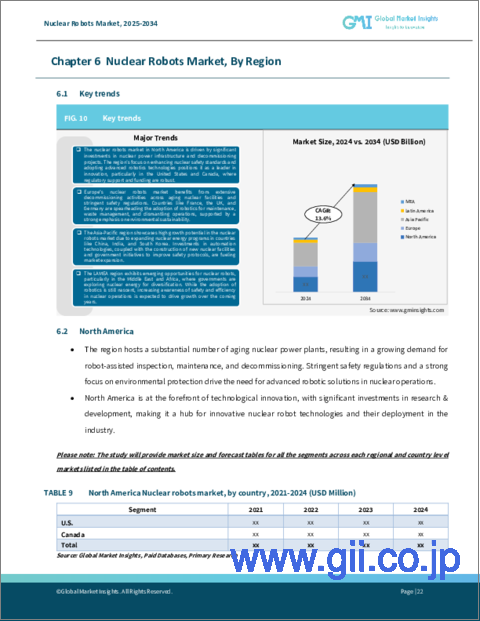|
|
市場調査レポート
商品コード
1535787
原子力ロボット市場:タイプ別、最終用途産業別、予測、2024年~2032年Nuclear Robots Market - By Type (Remote Manipulators, Crawlers, Aerial Drones, Underwater Robots (ROVs), Humanoid Robots), By End-use Industry & Forecast, 2024 - 2032 |
||||||
カスタマイズ可能
|
|||||||
| 原子力ロボット市場:タイプ別、最終用途産業別、予測、2024年~2032年 |
|
出版日: 2024年06月13日
発行: Global Market Insights Inc.
ページ情報: 英文 220 Pages
納期: 2~3営業日
|
全表示
- 概要
- 目次
世界の原子力ロボット市場は、研究開発の大幅な進歩により、2024年から2032年の間に10%を超えるCAGRを記録します。
原子力発電所や施設が安全性、効率性、自動化にますます重点を置くようになるにつれ、原子力ロボットは不可欠なツールになりつつあります。これらのロボットは、高放射線環境で点検、保守、廃止措置などの危険な作業を行い、人間が危険な状況にさらされるのを最小限に抑えます。例えば、2024年3月、米国エネルギー省アルゴンヌ国立研究所の研究者は、原子力施設における有害廃棄物の浄化を強化することを目的とした遠隔操作テレロボティクス・システムを披露しました。
最近の研究開発の動向は、より高い精度と信頼性で複雑な作業を処理できる、より多用途で洗練されたロボットの開発につながっています。革新的な技術には、機動性の向上、放射線遮蔽の改善、リアルタイムのデータ収集のための高度なセンサーなどがあります。原子力エネルギーが世界のエネルギーミックスにおいて重要な役割を果たし、施設が老朽化するにつれて、厳しい環境でも安全かつ効果的に動作するロボットシステムの必要性が高まっています。その結果、技術の継続的な進歩と安全性への注目が、原子力ロボット市場の力強い成長を促しています。
タイプ別に見ると、クローラー分野の原子力ロボット市場の収益は、2024年から2032年にかけて顕著なCAGRを記録します。クローラーロボットは、原子力施設内の複雑で危険な地形を移動し、点検、保守、がれき除去などの作業を行うために設計されています。その堅牢な設計により、高放射線地帯での作業を可能にすると同時に、人間が危険な状況にさらされるのを最小限に抑えることができます。最近の進歩により、操縦性、耐久性、センサー機能が向上し、厳しい環境での有効性が高まっています。原子力マテリアルの安全かつ効率的なハンドリングとサイトメンテナンスの必要性が高まるにつれ、クローラ型ロボットの重要性が増しており、原子力ロボット市場の大幅な成長を牽引しています。
最終用途別では、放射線クリーンアップ分野が2024年から2032年にかけて顕著な成長を遂げると思われます。これらのロボットは、放射性物質の影響を受けた環境を管理・汚染除去し、人間が危険な状況にさらされるのを大幅に減らすために極めて重要です。放射線浄化用に設計された先進的なロボットは、放射性瓦礫の安全な取り扱いと除去、現場検査の実施、精密な除染作業を行うための特殊なセンサーやツールを備えています。原子力施設が老朽化し、効果的な廃止措置や廃棄物管理の必要性が高まるにつれ、放射線清掃ロボットの役割はますます重要になっています。このような放射性物質の安全性と効率的な取り扱いの必要性が、原子力ロボット市場の大きな成長を促しています。
欧州の原子力ロボット市場は、2024年から2032年にかけて顕著なCAGRを示すと思われます。欧州諸国は、老朽化した原子力施設の管理、廃炉プロセス、放射性廃棄物の取り扱いを強化するため、ロボット技術に投資しています。これらのロボットは、危険な作業の遂行、放射線被曝の低減、作業効率の向上において重要な役割を果たしています。欧州が高い安全基準の維持と持続可能な原子力ソリューションの探求に取り組む中、先進的な原子力ロボットへの需要が高まっています。この動向は、市場の拡大と技術革新を促進する、欧州全域での重要な研究開発努力によって支えられています。
目次
第1章 調査手法と調査範囲
第2章 エグゼクティブサマリー
第3章 業界洞察
- エコシステム分析
- ベンダー・マトリックス
- 利益率分析
- テクノロジーとイノベーションの展望
- 特許分析
- 主要ニュースと取り組み
- 規制状況
- 影響要因
- 促進要因
- 原子力需要の増加
- 安全性とセキュリティに対する懸念の高まり
- 原子力廃止措置需要の増加
- 原子力の世界的拡大
- 継続的な技術進歩
- 業界の潜在的リスク&課題
- 複雑性と統合
- サイバーセキュリティの脆弱性
- 促進要因
- 成長可能性分析
- ポーター分析
- PESTEL分析
第4章 競合情勢
- イントロダクション
- 企業シェア分析
- 競合のポジショニング・マトリックス
- 戦略展望マトリックス
第5章 原子力ロボット市場の推計・予測:タイプ別、2021年~2032年
- 主要動向:タイプ別
- 遠隔マニピュレーター
- クローラー
- 空中ドローン
- 水中ロボット(ROV)
- ヒューマノイドロボット
第6章 原子力ロボット市場の推計・予測:最終用途別、2021年~2032年
- 主要動向:用途別
- 放射性廃棄物処理
- 原子力廃止措置
- 放射線浄化
- 原子力発電所
- 調査・探査
- その他
第7章 市場推計・予測:地域別、2021年~2032年
- 主要動向
- 北米
- 米国
- カナダ
- 欧州
- 英国
- ドイツ
- フランス
- イタリア
- スペイン
- その他欧州
- アジア太平洋
- 中国
- インド
- 日本
- 韓国
- その他アジア太平洋地域
- ラテンアメリカ
- ブラジル
- メキシコ
- その他ラテンアメリカ
- 中東・アフリカ
- UAE
- 南アフリカ
- サウジアラビア
- その他の中東・アフリカ
第8章 企業プロファイル
- AB Precision(Poole)Ltd
- Areva
- Boston Dynamics
- Brokk Global
- Clearpath Robotics
- Diakont
- Hitachi, Ltd.
- James Fisher Technologies
- KUKA AG
- Mitsubishi Heavy Industries
- QinetiQ
- Reach robotics
- Robotnik
- SuperDroid Robots
- Walischmiller Engineering GmbH
- Westinghouse Electric Company
Global Nuclear Robots Market will witness over 10% CAGR between 2024 and 2032, driven by significant advancements in research and development. As nuclear power plants and facilities increasingly focus on safety, efficiency, and automation, nuclear robots are becoming essential tools. These robots perform hazardous tasks such as inspection, maintenance, and decommissioning in high-radiation environments, minimizing human exposure to dangerous conditions. For instance, in March 2024, researchers at the U.S. Department of Energy's Argonne National Laboratory showcased a remote-operated telerobotics system aimed at enhancing hazardous waste cleanup at nuclear sites.
Recent R&D efforts have led to the development of more versatile and sophisticated robots capable of handling complex tasks with greater precision and reliability. Innovations include enhanced mobility, improved radiation shielding, and advanced sensors for real-time data collection. As nuclear energy plays a crucial role in the global energy mix and as facilities age, the need for robotic systems that can operate safely and effectively in challenging environments grows. Consequently, ongoing advancements in technology and a focus on safety are driving robust growth in the nuclear robots market.
The overall Nuclear Robots Industry is classified based on the type, end-use, and region.
Based on type, the nuclear robots market revenue from the crawlers segment will register a commendable CAGR from 2024 to 2032. These crawler robots are engineered to navigate complex and hazardous terrains within nuclear facilities, performing tasks such as inspection, maintenance, and debris removal. Their robust design allows them to operate in high-radiation zones while minimizing human exposure to dangerous conditions. Recent advancements have improved their maneuverability, durability, and sensor capabilities, enhancing their effectiveness in challenging environments. As the need for safe and efficient handling of nuclear materials and site maintenance grows, crawler-type robots are becoming increasingly vital, driving substantial growth in the nuclear robots market.
In terms of end-use, the radiation cleanup segment will witness an appreciable growth from 2024 to 2032. These robots are crucial for managing and decontaminating environments affected by radioactive materials, significantly reducing human exposure to hazardous conditions. Advanced robots designed for radiation cleanup are equipped with specialized sensors and tools to safely handle and remove radioactive debris, perform site inspections, and conduct precise decontamination tasks. As nuclear facilities age and the need for effective decommissioning and waste management grows, the role of radiation cleanup robots becomes increasingly important. This need for safety and efficiency in handling radioactive materials is driving significant growth in the nuclear robots market.
Europe nuclear robots market will exhibit a notable CAGR from 2024 to 2032. European countries are investing in robotic technology to enhance the management of aging nuclear facilities, decommissioning processes, and radioactive waste handling. These robots play a critical role in performing hazardous tasks, reducing human exposure to radiation, and improving operational efficiency. With Europe's commitment to maintaining high safety standards and exploring sustainable nuclear solutions, the demand for advanced nuclear robots is increasing. This trend is supported by significant research and development efforts across the continent, fostering market expansion and technological innovation.
Table of Contents
Chapter 1 Methodology & Scope
- 1.1 Market scope & definition
- 1.2 Base estimates & calculations
- 1.3 Forecast calculation
- 1.4 Data sources
- 1.4.1 Primary
- 1.4.2 Secondary
- 1.4.2.1 Paid sources
- 1.4.2.2 Public sources
Chapter 2 Executive Summary
- 2.1 Nuclear robots industry 360° synopsis, 2021 - 2032
- 2.2 Business trends
- 2.2.1 Total addressable market (TAM), 2024-2032
Chapter 3 Industry Insights
- 3.1 Industry ecosystem analysis
- 3.2 Vendor matrix
- 3.3 Profit margin analysis
- 3.4 Technology & innovation landscape
- 3.5 Patent analysis
- 3.6 Key news and initiatives
- 3.7 Regulatory landscape
- 3.8 Impact forces
- 3.8.1 Growth drivers
- 3.8.1.1 Increasing demand for nuclear energy
- 3.8.1.2 Growing concerns about safety and security
- 3.8.1.3 Rising demand for nuclear decommissioning
- 3.8.1.4 Global expansion of nuclear energy
- 3.8.1.5 Ongoing technological advancement
- 3.8.2 Industry pitfalls & challenges
- 3.8.2.1 Complexity and Integration
- 3.8.2.2 Cybersecurity Vulnerabilities
- 3.8.1 Growth drivers
- 3.9 Growth potential analysis
- 3.10 Porter's analysis
- 3.10.1 Supplier power
- 3.10.2 Buyer power
- 3.10.3 Threat of new entrants
- 3.10.4 Threat of substitutes
- 3.10.5 Industry rivalry
- 3.11 PESTEL analysis
Chapter 4 Competitive Landscape, 2023
- 4.1 Introduction
- 4.2 Company market share analysis
- 4.3 Competitive positioning matrix
- 4.4 Strategic outlook matrix
Chapter 5 Nuclear Robots Market Estimates & Forecast, By Type, 2021-2032, (USD Million)
- 5.1 Key trends, by type
- 5.2 Remote manipulators
- 5.3 Crawlers
- 5.4 Aerial drones
- 5.5 Underwater robots (ROVs)
- 5.6 Humanoid robots
Chapter 6 Nuclear Robots Market Estimates & Forecast, By End-Use, 2021-2032, (USD Million)
- 6.1 Key trends, By End-Use
- 6.2 Nuclear waste handling
- 6.3 Nuclear decommissioning
- 6.4 Radiation cleanup
- 6.5 Nuclear power plants
- 6.6 Research and exploration
- 6.7 Others
Chapter 7 Market Estimates & Forecast, By Region, 2021 - 2032 (USD Million)
- 7.1 Key trends
- 7.2 North America
- 7.2.1 U.S.
- 7.2.2 Canada
- 7.3 Europe
- 7.3.1 UK
- 7.3.2 Germany
- 7.3.3 France
- 7.3.4 Italy
- 7.3.5 Spain
- 7.3.6 Rest of Europe
- 7.4 Asia Pacific
- 7.4.1 China
- 7.4.2 India
- 7.4.3 Japan
- 7.4.4 South Korea
- 7.4.5 Rest of Asia Pacific
- 7.5 Latin America
- 7.5.1 Brazil
- 7.5.2 Mexico
- 7.5.3 Rest of Latin America
- 7.6 MEA
- 7.6.1 UAE
- 7.6.2 South Africa
- 7.6.3 Saudi Arabia
- 7.6.4 Rest of MEA
Chapter 8 Company Profiles
- 8.1 AB Precision (Poole) Ltd
- 8.2 Areva
- 8.3 Boston Dynamics
- 8.4 Brokk Global
- 8.5 Clearpath Robotics
- 8.6 Diakont
- 8.7 Hitachi, Ltd.
- 8.8 James Fisher Technologies
- 8.9 KUKA AG
- 8.10 Mitsubishi Heavy Industries
- 8.11 QinetiQ
- 8.12 Reach robotics
- 8.13 Robotnik
- 8.14 SuperDroid Robots
- 8.15 Walischmiller Engineering GmbH
- 8.16 Westinghouse Electric Company






